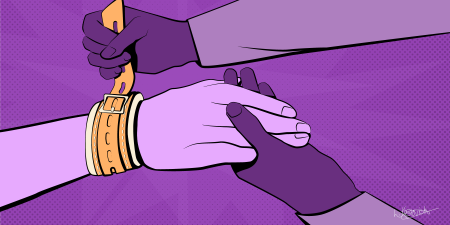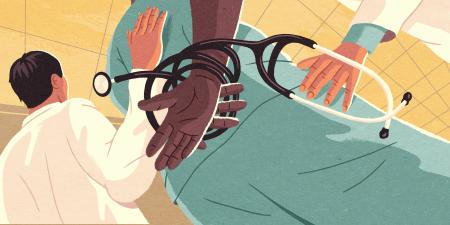Abstract
This article focuses on uses of force in clinical settings after a triggering event—a behavioral or medical crisis—and considers how force should be implemented. The clinical stakes are high, as force can undermine therapeutic capacity in patient-clinician relationships, exacerbate moral distress, and erode trust. Yet they are rarely discussed. This article explores compassionate use of force rather than merely minimally harmful use of force and considers how and by whom force should be executed; the nature and scope of goals, motivations, and protocols that should guide caregivers who must implement force protocols; and what a good compassionate force protocol might look like.
When compassion is intentional, a force protocol is part of a relational approach to taking good care of a patient.
Patient Rights and Force
Compassionate use of force is not a combination of words destined to join the ranks of oxymorons, but rather a concept that can be implemented in practice and protocol development. Existing tenets pertaining to uses of force in health care are currently based on patient rights, which can be mandated and enforced via civil means (fines) or legal means (suits or charges). The Centers for Medicare and Medicaid Services (CMS) defines and sets standards for patient rights regarding force in hospitals (see Table 1).1
| Definitions |
|
| Standards |
|
| Adapted from Condition of participation: patient’s rights.1 |
Patient rights are instrumental in expressing the ethical principles of respect for persons, patient autonomy, informed consent, just care, and other values that improve health care service delivery.2 Compassionate care and a compassionate use of force, however, can be difficult to define and arguably even more difficult to codify or mandate.3 Chochinov presents a concise description of compassion that’s useful here:
Compassion refers to a deep awareness of the suffering of another coupled with the wish to relieve it. Compassion speaks to feelings that are evoked by contact with the patient and how those feelings shape our approach to care. Like empathy (identification with and understanding of another’s situation, feelings, and motives), compassion is something that is felt, beyond simply intellectual appreciation.4
Awareness of suffering and the motivation to relieve it, as described by Chochinov, are at the heart of compassionate care. Sinclair et al generated an empirically based clinical model of compassion that encompasses patient-defined virtues, including genuineness, love, honesty, openness, authenticity, understanding, tolerance, kindness, and acceptance.5 When expressed by clinicians’ demeanors, behaviors, attention, and treatment, these virtues promote patients’ experience of compassionate care.5 Compassion also requires that clinicians treat each other with compassion,6 as compassion is part of a caring climate. This cultural dimension of health care delivery is not lost on patients and is key to clinicians’ ability to apply force with compassion.
Compassionate Force
In general, force protocols are implemented when a behavioral or medical crisis presents an imminent threat of harm or actual harm to self or others. A crisis’ etiology can be psychiatric, substance induced, related to a medical condition, or iatrogenic. These etiologies can inform a patient's course of treatment as caregivers pursue their common goals of becoming fully aware of patients’ symptoms of psychomotor agitation (see Table 2) and other signs of their experiences of suffering, which could trigger the need to use force to try to relieve that patient’s suffering.3,7
| Type | Behaviors and Experiences | |||||
|---|---|---|---|---|---|---|
|
Verbal |
- Raised voice |
|||||
|
Behavioral |
- Facial tension |
|||||
|
Cognitive |
- Delusions |
|||||
|
Physical |
- Labile vital signs |
|||||
|
Adapted from Iroku-Malize T, Grissom M7; Ringer L8; Helman A.9
|
||||||
A consensus statement of the American Association for Emergency Psychiatry, Project BETA (Best Practices in Evaluation and Treatment of Agitation) De-escalation Workgroup in 2012 delineated first steps for managing a patient with agitation: ensure the safety of the patient, staff, and others; help the patient manage their emotions and distress; help the patient maintain or regain control of their behavior; and avoid coercive interactions that could escalate the patient’s agitation.10
As in emergency departments, clinics, nursing homes, and other settings where agitated patients are commonly treated,7,9,11 de-escalation is widely regarded as key in crisis intervention.12 Compassionate behaviors such as empathizing, listening, and inquiring can help de-escalate a crisis and inform intervention strategy. Learning to empathize with patients experiencing agitation from dementia, for example, inspires confidence13 and can change clinicians’ linguistic descriptions of agitated patients—from aggressive and disruptive, for example, to frightened, frustrated, and struggling with an unmet need.13 When clinicians focus on learning more about a patient’s experience and on fulfilling an agitated patient’s unmet need in this way, force might not be needed.8 Inquiring about a patient’s experiences with prior interventions can also help clinicians remain present with a patient in crisis, help a patient feel safe, and help build trust (see Table 3).
| Type | Examples | |||||
|---|---|---|---|---|---|---|
|
Verbal |
- Be present and calm |
|||||
|
Environmental |
- Offer the patient unrestrained seclusion in their room or in a seclusion room with the door open |
|||||
|
Pharmacologic |
- Offer medications; ask which medications help the most and involve patient in the choice |
|||||
|
Safety |
- Enlist enough staff |
|||||
|
Adapted from Ringer L8; Registered Nurses’ Association of Ontario11; Kontio R, Välimäki M, Putkonen H, Kuosmanen L, Scott A, Joffe G.14
|
||||||
If or when de-escalation starts to fail and force is needed to maintain safety, it is important for clinicians to clearly inform the patient that they must regain control or the strategy for keeping everyone safe will change.15 If force is needed, the language used by clinicians becomes relevant again. For example, labeling an intervention minimally harmful suggests we don’t really see that intervention as appropriate treatment, in terms of the likelihood of benefit to the patient outweighing the risk of harm. Forcibly using antipsychotic medication to treat a patient who is not safe or making others unsafe is a compassionate clinical decision; this medication should be administered forcibly, if needed to maintain safety, with the goal of ameliorating the patient’s suffering and restoring the patient’s own capacity to remain safe, not with the goal of chemically restraining the patient.16 Language transforms the clinician-speaker from a chemical restrainer (abrogator of freedom) to a giver of appropriate medication (reliever of suffering).16 When compassion is intentional, a force protocol is part of a relational approach to taking good care of a patient.
Project BETA Guidelines
The American Association of Emergency Psychiatry’s Project BETA (Best practices in Evaluation and Treatment of Agitation) keeps compassion and relief of suffering at its center. If patients experiencing escalating agitation relay or demonstrate that they can refrain from physically harming themselves, open seclusion and observation can be implemented.17 In open seclusion, distractions (eg, reading materials, music, film, and puzzles) can be useful18 and are commonly used to manage agitation in patients with dementia8 or other patients demonstrating an inability to redirect themselves to relieve their own suffering. Clinicians who are aware of patients’ inability to self-soothe can help by offering distractions and, if patients cannot refrain from harming themselves or others, restraining and involuntarily medicating them for their own and others’ protection.17 The physical and psychological needs of patients must be attended to while they are restrained or secluded. A clinician must continually evaluate1 restrained or secluded patients; this presence with the patient is integral to compassionate caregiving.5 A clinician must also enlist restrained or secluded patients in their own release as soon as possible1; ongoing patient-clinician dialogue acknowledges and promotes relief of patients’ suffering and begins the process of restoring patients’ autonomous action.
The relational nature of compassionate care in situations that require force is exemplified by Tan et al’s 2010 study,19 which examined attitudes of patients with anorexia nervosa toward compulsory treatment and forced nutrition. All participants agreed that implementing force to save life was indicated and acceptable. Importantly, this evaluation of acceptability was based not on clinicians’ obligation to try to save patients’ lives when illness abrogated their capacity but on patients’ perceptions of both compassionate care and clinicians’ intentions to help them.19 In this way, the compassionate delivery of care helps patients cope with the necessary use of force.
Compassion Fatigue Undermining Compassion
Because compassion is relational and cultural, compassionate care does not start and end with patients but extends to clinical staff caring for patients. Compromised patients assaulting clinicians and staff occurs far too often. For nurses, this occurs most often in emergency departments, inpatient psychiatry units, and nursing homes,20 and long-term effects of violence against nurses include their developing negative coping strategies and experiencing stress, anxiety, fear, guilt, self-blame, and burnout.21 Burnout among clinicians is related to compassion fatigue, which results from “prolonged, continuous and intense contact with patients, the use of self, and exposure to stress”22 and is a threat to nurturing compassionate intention. Compassion fatigue is characterized by exhaustion; anger and irritability; negative coping behaviors, including alcohol and drug use; reduced capacity for feeling sympathy and empathy; diminished sense of enjoyment or satisfaction with work; increased absenteeism; and impaired decision making.23 Preserving clinicians’ compassionate intentions and motivations during the application of force in the course of caring for patients depends on addressing burnout, mitigating compassion fatigue, and adequately staffing units with acutely ill patients experiencing agitation that’s hard to manage while preserving safety.24
Physicians are often removed from an actual use of force event, and this is another reason to foster a compassionate culture that values the labor of and expresses respect for those implementing force protocols. When physicians aren’t part of force implementation, they have a responsibility to offer leadership in nurturing a compassionate culture of collegiality and patient care. After force is implemented in the care of a patient, a physician must assess the patient at the next available opportunity (a patient right per CMS) and should order indicated changes to the patient’s care plan. A physician can also assess and care for colleagues involved in a force event.25 Compassionate care decreases clinician burnout, which in turn improves patient outcomes.26 For this reason, medical systems are working to implement compassionate care in the psychiatric field and as a core component in the delivery of medical care.3,6,11,13
Compassionate Force Protocol
Even when justifiable, force can undermine therapeutic capacity in patient-clinician relationships and must be forthrightly acknowledged as inherently coercive. The patient rights codified by CMS are designed to prevent abuse and to guide harm reduction when force is needed to preserve or restore safety. Harm reduction, however, should not be regarded as sufficient in safeguarding patients who are restrained or secluded. In psychiatric settings, for example, patients who experienced force reported that their psychological distress was contributed to by lack of information, unmet basic needs, inadequate communication from caregivers, and absence of post-seclusion follow-up.18,27,28 They also reported feeling publicly humiliated, lonely, helpless, abandoned, and punished.18 One thing these findings should prompt us to ask is this: From whose perspective is harm deemed “reduced” or sufficiently reduced, particularly if the goal is safety?
Other patients, however, found seclusion helpful, as it afforded them an opportunity to collect themselves, reenergize, and heal; they felt protected as a result of being forced to refrain from performing actions they might later regret.18 Factors that mitigate patients’ negative reactions to restraint and seclusion include clinicians sharing relevant information with patients, staff members’ quick and efficient actions and calm presence, the delivery of comfort care, and patient enlistment in a release plan and post-event debriefing.27 Post-event debriefing offers opportunities for patients to share their experiences of forced intervention and should be used to collaboratively inform subsequent care planning for patients.27 The patients with anorexia nervosa in the Tan et al study, for example, reported that attentiveness and compassion from clinicians mitigated their negative experiences of forced intervention and opened the possibility of their seeing that the forced intervention was therapeutic.29 These factors suggest that forced interventions need not merely aspire to a clinical and ethical minimum of harm reduction but can be implemented with compassion. A compassionate force protocol is presented in the Figure.
Figure. Protocol for Compassionate Implementation of Force in Health Care Settings
| Step 1: Assessment of a Behavioral Crisis |
|
| Step 2: Pending Behavioral Crisis |
|
| Step 3: Use of Force |
|
| Step 4: Debrief |
|
Conclusion
This article posits that force can and should be implemented compassionately. Compassion is an indicator of quality for patients5 and should be regarded as an indicator of good character and collegiality among clinicians. Explicitly integrating patient rights into compassionate care offers therapeutic possibility in cases in which force is needed to preserve or restore safety and offers clinicians intellectual room and space to perform and assess their actions as healers with skill and intention rather than as judges, safety monitors, or adherence enforcers. Compassionate care incorporates clinician presence, patient-clinician sharing and dialogue, reassurance, kindness, empathy, and attentiveness as factors that can mitigate patients’ negative experiences of forced interventions and preserve therapeutic capacity in patient-clinician relationships.
References
-
Condition of participation: patient’s rights. Fed Regist. 2006;482(13):71426-71428.
-
Olejarczyk JP, Young M. Patient rights. In: StatPearls. StatPearls Publishing; 2020. Updated September 7, 2020. Accessed October 7, 2020. https://www.ncbi.nlm.nih.gov/books/NBK538279/
-
Paterson R. Can we mandate compassion? Hastings Cent Rep. 2011;41(2):20-23.
- Chochinov HM. Dignity and the essence of medicine: the A, B, C, and D of dignity conserving care. BMJ. 2007;335(7612):184-187.
- Sinclair S, McClement S, Raffin-Bouchal S, et al. Compassion in health care: an empirical model. J Pain Symptom Manage. 2016;51(2):193-203.
- O’Driscoll M, Allan H, Liu L, Corbett K, Serrant L. Compassion in practice—evaluating the awareness, involvement and perceived impact of a national nursing and midwifery strategy amongst healthcare professionals in NHS trusts in England. J Clin Nurs. 2018;27(5-6):e1097-e1109.
- Iroku-Malize T, Grissom M. The agitated patient: steps to take, how to stay safe. J Fam Pract. 2018;67(3):136-147.
-
Ringer L. Gentle Persuasion Approach: a nurse’s experience caring for persons with responsive behaviours in the acute care setting. Paper presented at: 2013 Mount Sinai Geriatrics Institute program, “Through the Looking Glass: Alice’s Adventures Continue Across the Continuum of Care”; June 27, 2013; New York, NY.
-
Helman A. Emergency management of the agitated patient with Margaret Thompson and Reuben Strayer. Emergency Medicine Cases. September 2018. Accessed July 30, 2020. https://emergencymedicinecases.com/emergency-management-agitated-patient/
- Richmond JS, Berlin JS, Fishkind AB, et al. Verbal de-escalation of the agitated patient: consensus statement of the American Association for Emergency Psychiatry Project BETA De-escalation Workgroup. West J Emerg Med. 2012;13(1):17-25.
-
Registered Nurses’ Association of Ontario. Appendix U: example: de-escalation tips and interventions to assist patient to cope. In: Promoting Safety: Alternative Approaches to the Use of Restraints. February 2012. Accessed July 30, 2020. https://rnao.ca/sites/rnao-ca/files/Promoting_Safety_-_Alternative_Approaches_to_the_Use_of_Restraints_0.pdf
- Compton MT, Demir Neubert BN, Broussard B, McGriff JA, Morgan R, Oliva JR. Use of force preferences and perceived effectiveness of actions among crisis intervention team (CIT) police officers and non-CIT officers in an escalating psychiatric crisis involving a subject with schizophrenia. Schizophr Bull. 2011;37(4):737-745.
- Pizzacalla A, Montemuro M, Coker E, et al. Gentle persuasive approaches: introducing an educational program on an orthopaedic unit for staff caring for patients with dementia and delirium. Orthop Nurs. 2015;34(2):101-107.
-
Kontio R, Välimäki M, Putkonen H, Kuosmanen L, Scott A, Joffe G. Patient restrictions: are there ethical alternatives to seclusion and restraint? Nurs Ethics. 2010;17(1):65-76.
-
Vieta E, Garriga M, Cardete L, et al. Protocol for the management of psychiatric patients with psychomotor agitation. BMC Psychiatry. 2017;17:328.
-
Zeller S. The end of chemical restraints: expert opinion. Psychiatric Advisor. March 3, 2017. Accessed July 30, 2020. https://www.psychiatryadvisor.com/home/practice-management/the-end-of-chemical-restraints-expert-opinion/
- Knox DK, Holloman GH Jr. Use and avoidance of seclusion and restraint: consensus statement of the American Association for Emergency Psychiatry Project Beta Seclusion and Restraint Workgroup. West J Emerg Med. 2012;13(1):35-40.
- Larue C, Dumais A, Boyer R, Goulet MH, Bonin JP, Baba N. The experience of seclusion and restraint in psychiatric settings: perspectives of patients. Issues Ment Health Nurs. 2013;34(5):317-324.
- Tan JOA, Stewart A, Fitzpatrick R, Hope T. Attitudes of patients with anorexia nervosa to compulsory treatment and coercion. Int J Law Psychiatry. 2010;33(1):13-19.
- Martinez AJ. Managing workplace violence with evidence-based interventions: a literature review. J Psychosoc Nurs Ment Health Serv. 2016;54(9):31-36.
-
Stevenson KN, Jack SM, O’Mara L, LeGris J. Registered nurses’ experiences of patient violence on acute care psychiatric inpatient units: an interpretive descriptive study. BMC Nurs. 2015;14:35.
- Ledoux K. Understanding compassion fatigue: understanding compassion. J Adv Nurs. 2015;71(9):2041-2050.
-
Mathieu F. Running on empty: compassion fatigue in health professionals. Rehab Community Care Med. Spring 2007. https://www.compassionfatigue.org/pages/RunningOnEmpty.pdf
- Espinosa L, Harris B, Frank J, et al. Milieu improvement in psychiatry using evidence-based practices: the long and winding road of culture change. Arch Psychiatr Nurs. 2015;29(4):202-207.
- Masters KJ, Huckshorn KA. The role of the psychiatrist in seclusion and restraint. Psychiatr Serv. 2020;71(5):511-513.
- Shanafelt TD, Noseworthy JH. Executive leadership and physician well-being: nine organizational strategies to promote engagement and reduce burnout. Mayo Clin Proc. 2017;92(1):129-146.
-
Lanthén K, Rask M, Sunnqvist C. Psychiatric patients experiences with mechanical restraints: an interview study. Psychiatry J. 2015;2015:748392.
- Cohen-Mansfield J. Nonpharmacologic treatment of behavioral disorders in dementia. Curr Treat Options Neurol. 2013;15(6):765-785.
- Theodoridou A, Schlatter F, Ajdacic V, Rössler W, Jäger M. Therapeutic relationship in the context of perceived coercion in a psychiatric population. Psychiatry Res. 2012;200(2-3):939-944.



